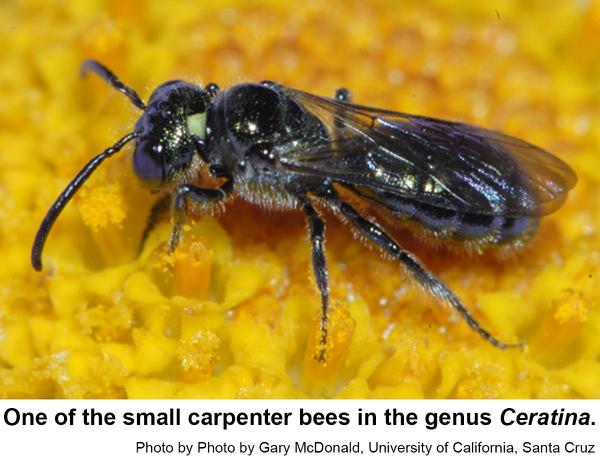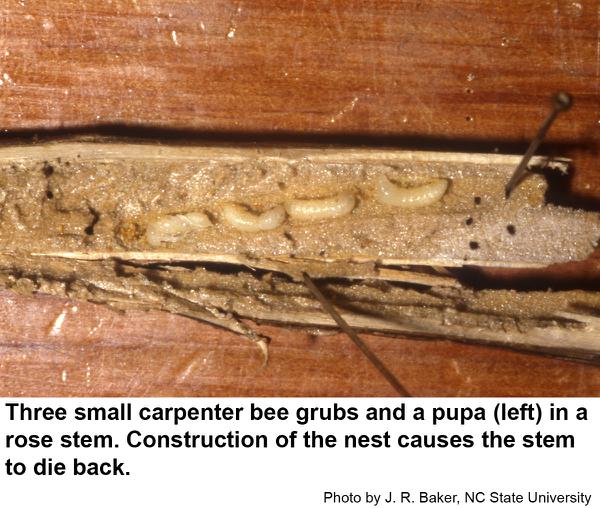Description and Biology
Small carpenter bees, genus Ceratina, are black with bluish green, or blue highlights. They sometimes have yellowish white markings on the face, thorax, and legs. These bees are no more than 3/8 inch long. All carpenter bees are solitary (a single female hollows out a nest without help of other bees). The larger Xylocopa carpenter bees bore into wooden beams or logs without bark, but Ceratina carpenter bees usually bore into broken stems of weeds or into the freshly cut stems of roses. This is a fairly rare, but where it does happen, small carpenter bees can give rose growers a fit because the stem dies back to the depth of the nest. Nests range from 1 ¼ to 12 inches deep! A female bee bores downward and then excavates a small cell that she provisions with a small ball of pollen moistened with nectar. She then lays an egg on the pollen ball, closes the cell with chewed up pith material, and constructs another cell closer to the nest entrance. This cell is provisioned with a pollen ball onto which she lays her next egg. Several cells are constructed, provisioned all with a single pollen ball onto which an egg is placed. Shortly after, the eggs hatch and tiny legless grubs feed and molt as they mature. Finally the grubs mature and pupate within their cells. A new generation of bees emerges a few weeks later. Small carpenter bees overwinter in excavated stems. The following spring, small carpenter bees emerge to forage and start constructing cells. Because they are solitary bees, small carpenter bees have no organized "nest guarding instinct" like the social bees and wasps. However, the female bee may remain with the nest, guarding it until all her progeny have emerged. The probability of getting stung by a small carpenter bee is very low.
Host Plants
Small carpenter bees have been reported nesting in the broken stems of “weeds,” rose stems, and sea oat stems. Females gather pollen and nectar from the flowers of at least 25 plant families that include rose, blackberry, and marguerite daisy.
Residential Recommendations
Ceratina carpenter bees can be discouraged by coating the freshly cut stems of roses with tree paint (probably the only valid use of tree paint). Small carpenter bees will then give up and move to a more favorable nesting site. Like other bees, small carpenter bees are sensitive to pesticides such as Sevin, Orthene and other insecticides labeled for landscape use. However, it seems un-American to kill pollinators.
References
- Genus Ceratina - Small Carpenter Bees. Anonymous. 2021 (updated). BugGuide. Iowa State University Department of Entomology.
- Common name: small carpenter bees, scientific name: Ceratina spp. (Insecta: Hymenoptera: Apidae: Xylocopinae). Grissell, E. E. and M. T. Sanford. 2017 (reviewed). Featured Creatures, Entomology & Nematology, FDACS, EDIS. Publication Number: EENY-101.
- Bees of the Eastern United States. II. Mitchell, T. B. 1962. North Carolina Agricultural Experiment Station Technical Bulletin No. 152. 557 pp.
- Guide to the Ceratina of Eastern North America. Droege, S. and S. Rehan. 2017? Discover Life, All living things, Ceratina.
- Extension Plant Pathology Publications and Factsheets
- Horticultural Science Publications
For assistance with a specific problem, contact your local N.C. Cooperative Extension Center.
This Factsheet has not been peer reviewed.
Publication date: Jan. 8, 2017
Revised: Oct. 14, 2019
Recommendations for the use of agricultural chemicals are included in this publication as a convenience to the reader. The use of brand names and any mention or listing of commercial products or services in this publication does not imply endorsement by NC State University or N.C. A&T State University nor discrimination against similar products or services not mentioned. Individuals who use agricultural chemicals are responsible for ensuring that the intended use complies with current regulations and conforms to the product label. Be sure to obtain current information about usage regulations and examine a current product label before applying any chemical. For assistance, contact your local N.C. Cooperative Extension county center.
N.C. Cooperative Extension prohibits discrimination and harassment regardless of age, color, disability, family and marital status, gender identity, national origin, political beliefs, race, religion, sex (including pregnancy), sexual orientation and veteran status.




